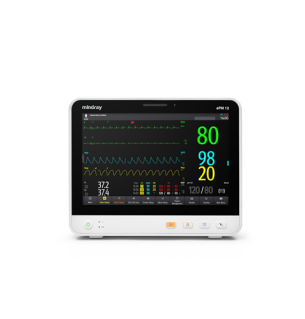Location: Queen Elizabeth the Queen Mother Hospital
Mindray’s neonatal dashboards on the ePM patient monitors, have provided Queen Elizabeth the Queen Mother (QEQM) Hospital’s Special Care Baby Unit with a safer, more efficient method of measuring oxygen saturation levels.
Oxygen saturation (SpO2) is one of the key parameters measured in the Special Care Baby Unit (SCBU) at QEQM, part of the East Kent Hospitals University Foundation Trust. So, when the unit began to see SpO2 data discrepancies in its older equipment, resulting in extended discharge times for its vulnerable patients, the Trust invested in eight Mindray ePM devices. With the new devices came Mindray’s specialised neonatal dashboards, which provided the unit with a safer, more efficient method of measuring oxygen saturation levels.
Challenges
- In-depth investigation revealed inconsistent SpO2 readings from older equipment
- Transferring babies between the High Dependency Unit (HDU) and the SCBU posed a patient safety risk due to SpO2 inconsistencies
- Lengthy sleep studies resulting in unnecessarily long discharge times and increased costs
How specialised data improved patient care
When a baby remained on oxygen for an extended period of time, the SCBU would carry out an in-depth study for the affected neonate, which would often have to be repeated for accuracy.
The new ePM devices allow QEQM’s consultants to see recorded SpO2 data in one easy-to-read display, with customisable targets for each individual baby. Specially created on Mindray devices for neonatal environments, the dashboard provided the foundation for a fundamental shift in how the unit provides care for its babies.
The ePM’s neonatal dashboard drastically improved data reliability and reduced the need for lengthy sleep studies, helping staff wean babies off oxygen using simple bedside data analysis, instead of a possible 8-day process involving posting sleep studies to their sister site for downloading and analysis.
With Mindray’s clinical applications team, the unit designed its own unique oxygen therapy tool within the dashboard, improving the clarity of data and speed of patient care.
The solution
- Consistent data: Eight new ePM patient monitors were ordered after SpO2 data inconsistencies were found in older equipment.
- Specialised neonatal dashboard: Patients benefit from a highly-specialised neonatal data screen, configured in conjunction with SCBU staff as a visual goal management tool for oxygen therapy in babies.
- Customisable targeting: SpO2 target tracking can be further defined into precise high and low limits for each baby, through an easy-to-read sliding scale graphic.
- Track SpO2 performance: With its extensive data storage capabilities, the ePM allows users to enter their target saturation parameters and track patient performance within a selected time duration (up to 48 hours).
- Perfusion Index (PI) display: The ePM’s PI and SpO2 data reassures users of the reliability and accuracy of saturation levels.
- Support and consultation: Mindray’s clinical application specialists helped maximise the potential in the neonatal dashboard, providing in-depth training and support.
Outcomes
- Enhancing patient care: Staff believe the neonatal saturation dashboard and the data it displays has helped wean babies off oxygen safely and more efficiently.
- Time for the parents: Parents now get to take their babies home sooner. With accurate, actionable saturation data presented each morning, staff at the SCBU have seen significant reductions in discharge times.
- Cost savings: Estimated at £32k per annum through reducing the average length of stay.
- Greater independence: Decision-making is now frequently done at the bedside, by the consultant, thanks to the wealth of accurate saturation data available – instead of a lengthy analysis process and potential delays.
- Time savings: The new devices have helped generate a 95% reduction in time-consuming sleep studies. Reduced from 22 studies in 2019 to just one so far in 2020.
- Data reliability: The neonatal dashboard was adopted by QEQM’s HDU, making Mindray’s SpO2 data the standard saturation measurement across the entire Trust, eliminating data consistency concerns between wards.
Conclusion
East Kent’s SCBU has fundamentally improved care for some of its most vulnerable patients, delivering babies back to their parents safer and faster than ever. The new system has helped the unit shorten the length of stay, increase data accuracy, and most importantly enhance patient safety.
New babies entering the unit are now supported by a smooth and safe transfer process, involving standardised saturation data which can be easily examined and monitored by staff at the bedside. Upon arrival, custom SpO2 targets can be set for individual babies and tracked through the night for morning analysis, resulting in faster discharge decisions.
Empowering the unit with these actionable saturation readings and customisable targets has improved patient care at an individual level and as a whole, saving money for the Trust by shortening the average length of stay in the process.
Mindray’s ability to produce such a significant improvement was met with great enthusiasm by the Trust, which subsequently installed the neonatal dashboard on all monitors in its HDU after recognising the software’s potential.



